Chronic pelvic pain in women
Pain can be constant or periodic, even paroxysmal, may be cyclical or not related to the menstrual cycle at all. Pain impulses that occur in the genitals and surrounding tissues as a result of irritation of nerve endings are transmitted to the central nervous system, which in most women is accompanied by general weakness, irritability, anxiety, excitability, emotional lability, attention disorders, memory loss, sleep disorders.
Chronic pelvic pain is characterized by:
-
constant pain in the lower abdomen and lower back of varying intensity and nature (pulling, dull, burning, etc.), prone to radiation lasting more than 6 months;
-
periodic exacerbations are pain crises that occur due to cooling, overwork, stress, etc.;
-
psycho-emotional disorders, manifested by insomnia, irritability, disability, anxiety and depression, decreased sexual function, up to a complete lack of interest and sexual response;
-
the absence or insignificant effect of conventional therapy with painkillers and antispasmodics.
In some cases, it is not possible to identify its causes even with an in–depth examination - this is the so-called "unexplained" pain. For such patients, the route along the "triangle"- gynecologist-urologist-neurologist becomes familiar, and pain and fear force them to contact an oncologist. These patients have often been treated for "inflammation of the uterus and appendages" for yearslarge doses of antibacterial drugs and such irrational treatment further aggravate the situation.
In many gynecological diseases, pain is one of the most common symptoms. External genital endometriosis, adhesive process in the pelvic cavity, chronic inflammatory diseases of the internal genital organs, internal endometriosis of the uterine body, Allen-Masters syndrome, tuberculosis of the genital organs, uterine fibroids
The most common misconceptions about chronic pelvic pain
The causes of chronic pelvic pain in women can only be gynecological diseases
In fact, chronic pelvic pain can cause diseases of the musculoskeletal system (osteochondrosis of the spine, myofascial syndromes, osteoarthritis of the sacrococcygeal joint, primary tumors of the pelvic bones, metastases to the pelvic bones and spine, bony forms of tuberculosis, pathology of the symphysis), retroperitoneal neoplasms, diseases of the peripheral nervous system (plexitis), diseases of the gastrointestinal tract diseases of the urinary tract (chronic colitis, irritable bowel syndrome, ulcerative colitis, proctitis, adhesions), diseases of the urinary system (chronic cystitis, urolithiasis, pelvic location of the kidney, kidney prolapse), vascular diseases (varicose veins of the pelvis). The causes of chronic pain syndrome can also be mental illnesses (abdominal epileptic seizures, depressive syndrome, schizophrenia).
Pain is usually caused by one factor, eliminating which can get rid of the pain
In fact, in most gynecological diseases, the origin of pain is caused by several stimuli at once, and it is often impossible to single out the leading factor. With uterine fibroids, pain can be caused by an increase in this organ, a violation of its blood supply and contractility of the uterine muscle, deformation of the uterine cavity by nodes, compression by the enlarged uterus or individual nodes of neighboring organs - intestines, urinary tract, nerve plexuses, blood vessels.
With tumors and cysts of the ovaries, the tissues and ligaments of the ovaries are stretched (up to twisting), follicle maturation is disrupted, microfractures with inflammation and adhesions are possible, compression of neighboring organs by cysts
Pelvic pain is characteristic of malformations of the genitals (normal or closed functioning uterus with cervical or vaginal aplasia, rudimentary uterine horn, closed cavity of a two-horned or doubled uterus) and other conditions accompanied by impaired outflow of menstrual blood (intrauterine synechia, cervical canal stenosis uterine or vaginal scarring). In these cases, the pain is caused by the stretching of closed cavities by blood and irritation of the peritoneum with almost constant hemoperitoneum, inflammation, and adhesions. Incorrect positions of the internal genitalia (bends of the uterus, abscesses, prolapses) also cause pelvic pain.
As a rule, most patients have a combined gynecological pathology, and each of the diseases can be the cause of pain. External endometriosis often accompanies any other gynecological disease, and uterine fibroids are combined with internal endometriosis of the uterine body. It is not uncommon to have a prolapse of the uterus affected by fibroids or adenomyosis. The presence of combined gynecological and extragenital pathology (hernias, diseases of the gastrointestinal tract, urinary tract, osteochondrosis of the spine) can significantly complicate the determination of the true cause of pain.
Periodic pain in women is normal
This myth has been prevalent since the 19th century. Doctors then explained menstrual pain by the instability and delicacy of women's physiology and believed that pain during menstruation was a norm that was very characteristic of the female body. Another "cause" of pain in women during menstruation is, as some believe, a low pain threshold.
In fact, many women and girls experience pain during menstruation. However, severe pain that disrupts a habitual lifestyle and activity level cannot be the norm, and they are usually based on some kind of disease, such as endometriosis, a hormone-dependent disease in which the uterine mucosa (endometrium) grows in other parts of the body. This is the third most common gynecological disease after uterine fibroids and various inflammatory processes in the genitals.
Therefore, every woman with severe pain during menstruation should be fully examined to identify their cause.
Early detection of the causes of pain determines the success of treatment. To identify possible causes of pelvic pain, we work in a unified team with doctors of other specialties - general surgeons, oncologists,urologists, neurologists, psychologists.
For the treatment of chronic pelvic pain, gynecological surgeons of the EMC use an approach based on reducing the invasiveness of surgery, avoiding excessive radicalism, and waiting tactics for certain diseases of the genital area.
Laparoscopy and hysteroscopy provide us with unique diagnostic and therapeutic opportunities, which allow us to identify and eliminate possible causes of pain that are not diagnosed by other examination methods: endometriosis of the pelvic peritoneum, adhesions, anatomical disorders - hernias, peritoneal defects (Allen-Masters syndrome).
From the patient's point of view, laparoscopic intervention, unlike laparotomy, is not perceived as a "large and severe" operation, and the absence of intense and prolonged postoperative pain associated with the surgical wound of the anterior abdominal wall eliminates the aggravation of the initial pain due to the layering of operating rooms on them. And finally, early activation and return to physical activity, with virtually no cosmetic defects, also contributes to a rapid recovery.
The volume of surgical intervention is selected by EMC gynecologists depending on the patient's age, her plans for childbirth, the severity of the detected pathology, and the severity of pain. Organ-preserving operations are performed in young women, warning patients about the likelihood of recurrence of diseases such as endometriosis and uterine fibroids. Patients of the older age groups with adenomyosis, multiple uterine fibroids, accompanied by severe pain, bleeding and leading to anemia, tumor growth and its significant size, impaired functions of neighboring organs, radical operations are indicated in the volume of removal of the uterus, which we perform by laparoscopy or vaginal access.
For pelvic organ prolapses and prolapses accompanied by pelvic pain, EMC gynecologists use surgical correction technologies that are fundamentally different from each other, depending on the patient's age, to effectively eliminate gynecological pathology and restore impaired pelvic anatomy. With varicose veins of the pelvic vessels, we perform laparoscopic ligation of the ovarian veins, which is highly effective against pelvic pain due to stagnation in the pelvic veins, while not adversely affecting ovarian function.
The effectiveness of surgical interventions performed by specialists of the Department of Gynecology and Oncogynecology of the EMC varies from 60 to 95%, which indicates the effectiveness of the treatment and the high level of training of specialists, whose experience allows them to take on even the most difficult cases.
The Clinic's doctors work under the guidance ofVladimir Nosov is an experienced oncogynecologist and obstetrician-gynecologist, certified by the US National Board Certified in Obstetrics and Gynecology and Oncogynecology, as well as certified in Russia in obstetrics and gynecology and oncology.
Why the EMC
The first and only clinic in Russia, created in the image of the world's leading clinics
EMC is a multidisciplinary center offering patients a high level of medical services and a personalized approach
Worldwide recognition and awards
 Learn more
Learn more
Worldwide recognition and awards
 Certificates and licenses
Certificates and licenses
Make an appointment for a consultation
Specify your contacts and we will contact you to clarify the details
and new products of the EMC
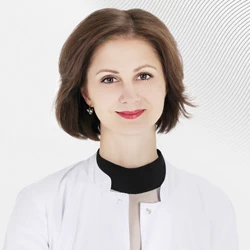
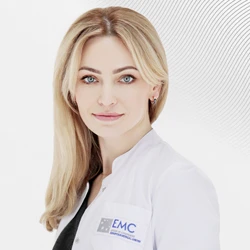
.webp)
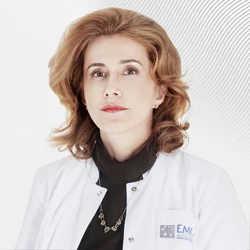
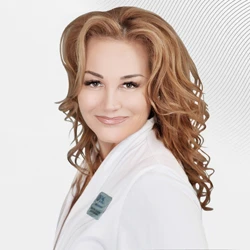

.webp)
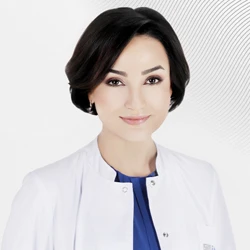
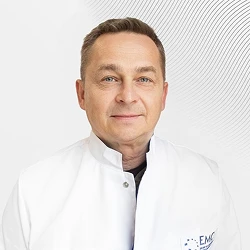

.webp)
